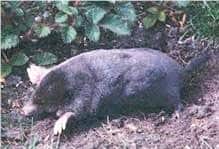Moles Pest Control
Moles are mammals that live under ground, burrowing holes. Moles have cylindrical bodies covered in fur with small or covered eyes; the ears are generally not visible. Moles are of the Family Talpidae: several genera and species, including the Eastern Mole ( Scalopus aquaticus) of North America. Moles feed on small invertebrate animals living under ground eg:earthworms& other soil inhabiting insects and their stages Moles remove many damaging insects and grubs from lawns and gardens. However, their burrowing habits destroy lawns and parks beauty, destroy flower beds, tear up the roots of grasses.
Moles have cylindrical bodies covered in fur with small or covered eyes; the ears are generally not visible. Moles are of the Family Talpidae: several genera and species, including the Eastern Mole ( Scalopus aquaticus) of North America. Moles feed on small invertebrate animals living under ground eg:earthworms& other soil inhabiting insects and their stages Moles remove many damaging insects and grubs from lawns and gardens. However, their burrowing habits destroy lawns and parks beauty, destroy flower beds, tear up the roots of grasses.
It is important to properly identify the kind of animal causing damage before setting out to control the damage. Moles and pocket gophers are often found in the same location and their damage is often confused. Control methods differ for the two species. Moles leave volcano-shaped hills that are often made up of clods of soil. The Mole hills are pushed up from the deep tunnels and may be 2 to 24 inches (5 to 60 cm) tall.The number of Mole hills is not a measure of the number of Moles in a given area. Surface tunnels or ridges are indicative of Mole activity. Pocket gopher mounds are generally kidney-shaped and made of finely sifted and cloddy soil. Generally, gophers leave larger mounds than Moles do. Gopher mounds are often built in a line, indicative of a deeper tunnel system. MoleControl and Mole Removal is the only way to Control Moles and Mole Breeding. A Mole Nuisance in the home can upset daily life and Removing Moles from the home can be even more challanging. Mole varieties vary greatly in size. Mole control for large Moles can be a challenge as well as Mole Control for small Moles. Mole Animal Control or Removal of Moles may be essential for human health and controlling Moles are mostly found in backyards of house.
The two most common mole varieties are star-nosed and eastern. They are nearly 7 inches long from nose to tail. They have broad, outward-facing pads on their front feet, small and narrow hind feet, and tiny pinholes for eyes; their ears are not visible. Moles use their paws to tunnel through the ground searching for ants, earthworms and grubs. They are insectivores who do not eat plants but feed mainly on earthworms, insect larvae and anthropoids. Some moles eat tubers and roots of garden plants. A person can easily find whether they have moles in their lawn or garden by seeing trenches and dug-up soil. Adult mole measures from 12 to 20 cm in length and has dark grey or brown, velvety fur. Moles do not hibernate but remain active day or night throughout the year. During winter, mole looks for food deep below the frost line.
Having moles in your garden or lawn can be beneficial as it can consume insects like larvae, slue, in addition there are some who eat small snakes and mice. But the disadvantage is it can destroy lawns, gardens, park, golf courses and cemeteries. They can kill planets when tunneling by removing soil around roots. Unprotected roots dry out and die.
Mole population is increasing rapidly throughout the word due to wet and mild winters. Hence it isimportant to use latest mole matching and mole trapping techniques. Major problem with moles are tunnels. They can leave ridged tunnels all over a lawn. They are not harmful but can ruin your nice landscape or yard. Average life span of a mole is around four years.



